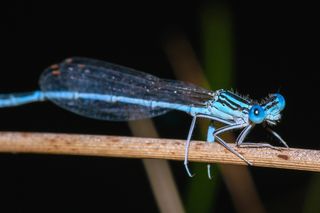
Do Bugs Poop?

Don't think too hard about this on your next picnic, but yes, bugs poop.
Insect poop is called "frass," and it can actually be a useful source of information for entomologists and biologists. New species have even been found in frass. And insects themselves use their poop for some pretty strange things, from inoculating their babies with symbiotic organisms to signaling others in their species to come hang out.
So first, the frass basics. Insect guts are roughly similar to human guts, inasmuch as they usually start with a mouth and end with an anus. The insect digestive system is divided into the foregut, the midgut and the hindgut, said Joe Ballenger, an entomologist who co-runs the website Ask an Entomologist. The foregut stores and grinds food, not unlike a bird's crop, Ballenger told Live Science. Most digestion takes place in the midgut, where nutrients are absorbed into the insect body. The hindgut is not unlike the large intestine, where water is taken back up before waste is excreted. [20 Startling Facts About Insects]
One notable difference between the human gut and the insect gut: When insects shed their exoskeletons, they shed the interior of their guts, too, Ballenger said.
Insect poop usually looks like tiny pellets, Ballenger said, with large insects producing larger poop. Wood-boring insects poop out what essentially looks like sawdust, Ballenger said (because it is sawdust), and cockroaches poop out what looks like ordinary household dust (but beware — cockroach poop is a nasty allergen). Termites are prolific poopers: Their mounds are made of partially digested wood and fecal material, Ballenger said.
Most insect poop gets recycled back into the environment and acts as fertilizer. But some insects have very specific uses for their frass. Bark beetles excrete pheromones in their feces that invite other bark beetles to come close. These "aggregation pheromones" are a way to attract mates and to kick-start other social behaviors.
And when female stinkbugs lay their eggs, they coat them with a layer of their own poop. As soon as the baby stinkbugs, called nymphs, hatch, they suck the poop off the remains of the eggs, Ballenger said. This turns out to be very important to the babies' health, because the poop contains symbiotic bacteria and other organisms.
Sign up for the Live Science daily newsletter now
Get the world’s most fascinating discoveries delivered straight to your inbox.
"If you separate [the stinkbugs] from the eggs, or even wash the eggs in a mild bleach solution, all the baby stinkbugs die because they don't get those symbionts," Ballenger said.
Symbionts are of interest to agricultural researchers, who hope that by targeting these crucial gut species, farmers might be able to kill off pests with fewer environmental side effects than traditional pesticides, Ballenger said.
Scientists are just beginning to discover the varied microbes inside insect poop. Researchers have found newspecies of yeast in insect poop in Thailand, in the feces of woodwasps and in the poop of the cocoa pest Conopomorpha cramerella.
But as with all things, there is an exception to the "everyone poops" rule. A few species of insect don't eat — and thus don't poop — in adulthood, Ballenger said. Mayflies and silk moths are examples of insects that have ditched longevity in their adult stage for a brief-but-fruitful burst of reproductive activity.
And then there are species that eat, but don't poop, at least for a while. Lacewings, which prey on many pest species, don't poop in their larval stage, Ballenger said. They have a blind gut (one with just a single opening), and all the waste gets "shoved to the back." When the larvae undergo metamorphosis as adults, the first thing they do is poop out everything they've stored up for their entire youth.
"If you think about human biology," Ballenger said, "that would be a really interesting celebration for a 21st birthday."
Original article on Live Science.

Stephanie Pappas is a contributing writer for Live Science, covering topics ranging from geoscience to archaeology to the human brain and behavior. She was previously a senior writer for Live Science but is now a freelancer based in Denver, Colorado, and regularly contributes to Scientific American and The Monitor, the monthly magazine of the American Psychological Association. Stephanie received a bachelor's degree in psychology from the University of South Carolina and a graduate certificate in science communication from the University of California, Santa Cruz.
Most Popular




